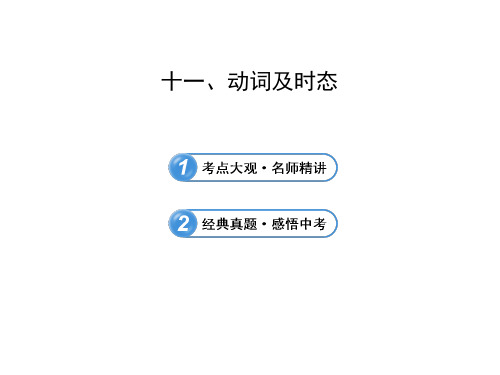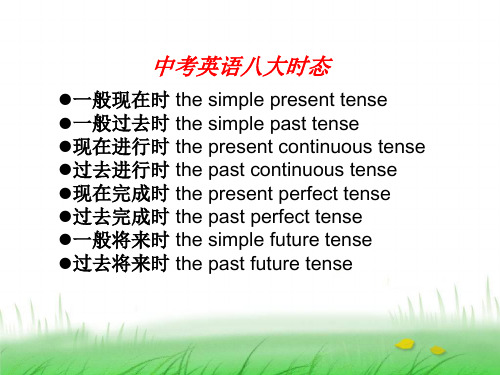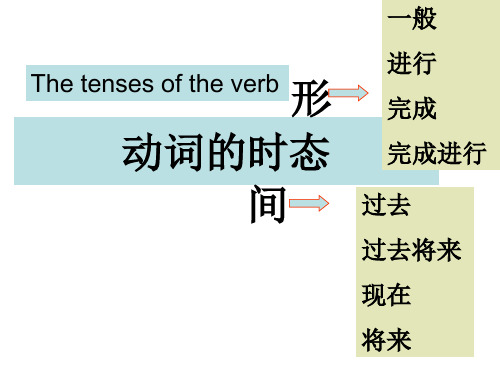初中英语动词时态复习课件PPT优质课件
合集下载
初中英语语法动词及时态ppt课件

过去进行时 主语+was/were+v. -ing+其他
现在完成时 主语+have/has+过去分词+其他
中学阶段见到的其他时态 时态
构成
过去完成时 主语+had+过去分词+其他
过去将来时
现在完成 进行时
主语+would+动词原形+其他 主语+was/were going to+动词原形
主语+have/has+been+现在分词+其他
状语
【温馨提示】
(1)在含有时间状语从句的复合句中,延续时间较长的动作用过 去进行时,另一个短暂性动作用一般过去时。例如:
My pen dropped on the ground when I was walking in the park. 在公园散步的时候,我的钢笔掉到地上了。
(2)表示两个延续性动作在过去某一时刻同时进行,不考虑动作 的先后顺序,主句和从句的谓语动词都用过去进行时,连词常 用while。例如:
词
宾语,又分为及物动词和 不及物动词。
物动 run , walk , cry , 词 swim,fall,happen
连
系 连接主语和表示主语身份、be , seem , look , become ,
动
性质、状态的动词称为连 get , grow , feel , appear ,
系动词。
turn
day等频率副词或时间状语 month.
连用
我们每月都去看望刘叔叔。
用法
例句
表示客观事实或普遍真理 The sun rises in the east. 太阳在东方升起。
初中英语六种时态复习课件(35张PPT)

②while 引导的从句表示“在……期间”,主从句谓语动词所表示的动 作同时ቤተ መጻሕፍቲ ባይዱ生。这时,主从句都用过去进行时。
e.g.:My father was reading the newspaper while my mother was watching TV.当我的妈妈看电视的时候,我的爸爸正在看报纸。
(2)表示普遍真理或客观事实。 e.g.:The sun rises in the east.太阳从东方升起。 (3)在条件状语从句和时间状语从句中,用一般现在时表示将来。 e.g.:If it doesn't rain tomorrow,we will go for a picnic.如果明天不下 雨,我们将去野餐。 (4)在某些以 here,there 开头的句子中用一般现在时表示正在发生的动作。 e.g.:There goes the bell.铃响了。
(3)现在进行时表示将来 表示位置移动的动词 go,come,leave,fly,start,meet,move 等, 可以用现在进行时表示将要发生的事。 e.g.:We are leaving for London.我们就要动身去伦敦了。
(4)一般现在时表示将来 ①表示按规定或时间表预计要发生的动作。 e.g.:Our plane takes off at 8:10.我们的飞机 8:10 起飞。 ②当主句为一般将来时,或含有情态动词,或是祈使句时,在 if,as soon as,until,when 等引导的状语从句中用一般现在时表示将来。 e.g.:I will give him the book as soon as he comes here.他一来这儿, 我就把这本书给他。
(2)表示当前一段时间内的活动或现阶段正在进行的动作。 e.g.:They are picking apples on a farm all the time.他们一直在农场 摘苹果。 (3)与 always,usually 等词连用,表达说话人强烈的感情,如赞扬、不 满、讨厌等。 e.g.:Mary is always thinking of others instead of herself.玛丽总是为 别人着想,而不为自己着想。
中考英语动词时态课件(38张PPT)

cried stopped
planned
get got take took go went swim swam eat ate drink drank are were have had do did come came cut cut put put say said see saw
1.The twins ___w_a__sh__e_d__(wash) the
Lily
Lucy
What a fine day today! Look....
过去进行时: Past Progressive 概念: 表示过去某一时刻或某一个时间段内 发生的动作 结构: be (was,were) + doing 标志语:at 8:00 yesterday 、 at that moment 、 when 、 while、…
一般过去时: Past Simple 概念: 表示过去经常或反复发生的动作 结构: did, was/were(过去时)
例句:I went to the park yesterday. I was happy yesterday.
标志语:yesterday、... ago、just now in 1992、 last week/month…
结构: have done/ been/gone(过去分词)
标志语:already、yet for 、since
get got gotten
go went gone
eat ate eaten
are were been
do did done
cut cut
cut
say said said
night
பைடு நூலகம்
went… visited…
planned
get got take took go went swim swam eat ate drink drank are were have had do did come came cut cut put put say said see saw
1.The twins ___w_a__sh__e_d__(wash) the
Lily
Lucy
What a fine day today! Look....
过去进行时: Past Progressive 概念: 表示过去某一时刻或某一个时间段内 发生的动作 结构: be (was,were) + doing 标志语:at 8:00 yesterday 、 at that moment 、 when 、 while、…
一般过去时: Past Simple 概念: 表示过去经常或反复发生的动作 结构: did, was/were(过去时)
例句:I went to the park yesterday. I was happy yesterday.
标志语:yesterday、... ago、just now in 1992、 last week/month…
结构: have done/ been/gone(过去分词)
标志语:already、yet for 、since
get got gotten
go went gone
eat ate eaten
are were been
do did done
cut cut
cut
say said said
night
பைடு நூலகம்
went… visited…
初中英语中考复习时态讲解课件(共79张ppt)

一般现在时
1. 表示经常性或习惯性的动作
She does excersice everyday.
真题链接
—What do you often do at weekends?
—I often ____ my grandparents.
A. visit
B. visited
C. have visited D. will visit
Just a moment, I am washing dishes.
when
习题
Just a minute! My brother________ his car in the garden. A. washes B. is washing C. washed D. will wash
习题
---Hey, Tom. Let’s go swimming.
动词过去分词 不规则变化
speak hear see give build swim buy teach
spoken heard seen given built swum bought taught
现在完成时
already yet
1.过去发生或已完成的某一动作对现在的影响。
I have already watched this film. I haven't watched this film yet. I have already visited America. I haven't visited America yet.
A. prepares
B. is preparing
C. has prepared D. prepared
真题链接
--Mum, it's late. Why are you still here? --Dad hasn't come back yet. I ____ for him. A. am waitingB. was waiting C. waited D. had waited
初中英语动词时态总复习(超级精华版).ppt

play leave swim
第三人称单数形式
plays leaves swims
以字母s,x,ch,sh,o结尾 的词加-es(读∕iz∕)
以辅音字母加y结尾的 词,先变y为i, 再加 -es(读∕z∕)
pass fix teach wish do
study carry
fly
passes fixes teaches wishes does
1)表示从过去某时看将要发生的动作或存在的状态。 常用于主句是一般过去时的宾语从句中。
例如:He said that he would finish his work before 9 o’clock.
他说他会在九点之前完成工作。
2)“was/were going to+动词原形”所表示的过去将来
时,表示过去曾经打算或将要做某事。
例如:She said she was going to buy a car.
她说她打算买一辆小汽车。
I would do my homework.
1.改为一般疑问句并回答。 Would you do your homework? Yes, I would./No, I wouldn't.
2.改为否定句。
4)表示客观真理,客观存在,自然现象。
例如:The earth moves around the sun.
地球绕太阳转动。
5)表示按计划或安排好的,或将要发生的动作, 可用一般现在时表将来。但只限于 start,begin,leave,go,come,arrive,return,take place 等。
初中英语动词时态复习
一、一般现在时 二、一般过去时
三、一般将来一时般现在四时、过去将来时 五、现在进行一时般现在六时、过去进行时 七、现在完成时 八、过去完成时
第三人称单数形式
plays leaves swims
以字母s,x,ch,sh,o结尾 的词加-es(读∕iz∕)
以辅音字母加y结尾的 词,先变y为i, 再加 -es(读∕z∕)
pass fix teach wish do
study carry
fly
passes fixes teaches wishes does
1)表示从过去某时看将要发生的动作或存在的状态。 常用于主句是一般过去时的宾语从句中。
例如:He said that he would finish his work before 9 o’clock.
他说他会在九点之前完成工作。
2)“was/were going to+动词原形”所表示的过去将来
时,表示过去曾经打算或将要做某事。
例如:She said she was going to buy a car.
她说她打算买一辆小汽车。
I would do my homework.
1.改为一般疑问句并回答。 Would you do your homework? Yes, I would./No, I wouldn't.
2.改为否定句。
4)表示客观真理,客观存在,自然现象。
例如:The earth moves around the sun.
地球绕太阳转动。
5)表示按计划或安排好的,或将要发生的动作, 可用一般现在时表将来。但只限于 start,begin,leave,go,come,arrive,return,take place 等。
初中英语动词时态复习
一、一般现在时 二、一般过去时
三、一般将来一时般现在四时、过去将来时 五、现在进行一时般现在六时、过去进行时 七、现在完成时 八、过去完成时
初中英语动词的时态和被动语态(共14张PPT)

延续性动词 be on be at/in+地点 be at/in+地点 be in/a member of be on have know keep
have a cold
have been to—have gone to
曾经去过(主语人在) 已经去了(主语人不在)
--I can’t find you these days.Where have you been?
be over be up be back be away (from) be here /there
非延续性动词 put on come/go to arrive/reach/get to join begin/start buy get to know borrow / lend
catch a cold
定义 表示过去某时间或某动作以前发生的动作。
结构 关健字
S+had+V过去分词
IwSr+heheaanlidzIner’det+aIVchh过ae去dd分let词hftemcoyupHnutar.sde+Sa+t Vh过om去分e词
by the time I came back,by the end of last term, when I got to the station,before he went to bed
表示过去某时刻或某阶段正在发生的动作。
was
1.SW+hawtawsna’st /hwe edroein’gt dwohinegn the UFO arrived?
结构 S+ weredoing 2W. Tahse/yWweerree+hSav+idnoginfugn…th?ese days.
初中英语语法—时态(28张) PPT课件 图文

(4)现在完成时与表示一段时间的for短语、since短语或从句等 时,应注意句中的谓语动词须是延续性的,而不能是非延续性动词,如 come→be here,go→be there,die→be dead,borrow→keep,buy→h ,join→be in,leave→be away,begin to study→study等。
6.过去进行时
(1)概念:表示过去某一时刻或某一时间段内正在进行的动作。 (2)构成形式:was/were+动词的-ing形式 ①表示往返、位移的动词的过去进行时常可用来表示过去将来时
时态 We wanted to tell her that the train was_leaving an hour later.
1.一般现在时
基本用法: (1)表示经常性、习惯性的动作; He always helps others. 他总是帮助别人。
时态 (2)表示现在的情况或状态;
He is a teacher. 他是个老师。 (3)表示客观事实和普遍真理。 The sun rises in the east. 太阳从东边升起。 构成形式:am/is/are或实义动词的原形(主语是第三人称单数时,动 词要用第三人称单数形式)。
时态 (2)构成形式:have/has+动词的过去分词。
(3)与现在完成时连用的时间状语有for a long time,recently,yet, lately,ever,never,already,since,by this time,before,just,in t past/last few years,since+过去的时间点,since+时间段+ago,since +从句(一般过去时)。
表示感觉的动词。如:see,hear等。 表示喜欢或厌恶的动词。如:like,love等。 表示希望的动词。如:want,would like等。
动词的时态和语态-PPT课件

8. The man _h_a_d__h_o_p_e_d__ (hope) to catch the last train, but he was too late.
9. The boys __w_e_r_e_p_l_a_y_in_g___ (play) basketball from 5:00 to 6:00 yesterday.Βιβλιοθήκη .19练习
.
20
用所给动词的正确形式填空: 1. She _l_e_ft__ (leave) the office two
hours ago. 2. As son as she arrived home, the girl
discovered that she _h_a_d__t_a_k_e_n__ (take) her friends book by mistake. 3. Who _c_o_m__e_s__ (come) to school earliest in your class every morning? 4. Great changes _h_a_v_e_t_a_k_e_n_p__la_c_e__ (take place) in this city since 1979. 5. By the time he was twelve, Edison _h_a_d__b_e_g_u_n_ (begin.) to sell newspape21rs.
I’ll go to see you when I have time. I’ll go to see you if I have time tomorrow. 2. 某些动词,如:stand, continue, wish, love, like, hate, feel, find, think等常用一般现在时态
9. The boys __w_e_r_e_p_l_a_y_in_g___ (play) basketball from 5:00 to 6:00 yesterday.Βιβλιοθήκη .19练习
.
20
用所给动词的正确形式填空: 1. She _l_e_ft__ (leave) the office two
hours ago. 2. As son as she arrived home, the girl
discovered that she _h_a_d__t_a_k_e_n__ (take) her friends book by mistake. 3. Who _c_o_m__e_s__ (come) to school earliest in your class every morning? 4. Great changes _h_a_v_e_t_a_k_e_n_p__la_c_e__ (take place) in this city since 1979. 5. By the time he was twelve, Edison _h_a_d__b_e_g_u_n_ (begin.) to sell newspape21rs.
I’ll go to see you when I have time. I’ll go to see you if I have time tomorrow. 2. 某些动词,如:stand, continue, wish, love, like, hate, feel, find, think等常用一般现在时态
- 1、下载文档前请自行甄别文档内容的完整性,平台不提供额外的编辑、内容补充、找答案等附加服务。
- 2、"仅部分预览"的文档,不可在线预览部分如存在完整性等问题,可反馈申请退款(可完整预览的文档不适用该条件!)。
- 3、如文档侵犯您的权益,请联系客服反馈,我们会尽快为您处理(人工客服工作时间:9:00-18:30)。
5、过去分词:规则变化与. 其过去式相同
请记住:
我们做这样的题时, 一般应掌握以下小技巧: (动词时态填空三部曲)
一看标志; 二定时态; 三写构成。
.
Let’s try how to use the trilogy.
(让我们尝试如何用三部曲做下面各题)
1、Look! The boy _is__re_a_d_i_ng__a book. (read) 提示:一找标志: Look!; 二定时态: 现在进行时; 三写构成: is reading
------我之所见、所学,仅供参考。
.
同学们,在上周,我们已经学习过现在完成时, 现在让我们一起回忆已经学过的时态,到现在为至, 我们学过的时态有:
一般现在时 一般过去时
现在进行时 过去进行时 一般将来时 现在完成时 下面请同学们来完成以下六题:
.
Let’s do some exercises about tenses we have learned.
.
Let’s try how to use the trilogy.
2、 I often ____w_a_lk___to school.(walk) 提示:一找标志:often 二定时态:一般现在时 三写构成:walk
.
Let’s try how to use the trilogy.
3、They __h_a_d___ fun last weekend.(have) 提示:一找标志 last weekend(过去 时间) 二定时态: 一般过去时 三写构成:had
.
真题演练----- 一般现在时与一般过去时的对比
1. Lucy usually__A____ to school .
(12, 26)
A walks
B is walk
C is walking
D has walked
剖析:这是2012年安徽省中考题,看四个选项,就知道考查
时态,根据句子里的标志usually, 我们就确定选一般现在时:用
1、Look! The boy _is__r_e_a_d_in_g_ a book. (read) 2、 I often __w__a_lk____to school.(walk) 3、They ___h_a_d__ fun last weekend.(have) 4、She _h_a_s__e_a_te_n_ breakfast already. (eat) 5、People _w_i_ll_h__a_v_e__ robots in 100 years.
.
Let’s try how to use the trilogy.
4、She _h_a_s_e_a_te_n__ breakfast already. (eat) 提示:一找标志:already 二定时态:现在完成时 三写构成:has eaten
.
Let’s try how to use the trilogy.
.
2.现在我们在这两个句子里找到一般现 在时的构成。 What doh TV.
请看下面两幅图 .
I played with my brother, then I cleaned my room.
What did you do yesterday?
usually, often, sometimes, every day/month/Monday/ ...., in the evening, on
动词原形/ 第三人称单数
Sunday....
yesterday, yesterday 动词的过去式 morning/afternoon..., (-ed) Last week/..., in 2011....
小明问他的好友Tom昨天做了啥,你们 知道他做什么了吗?
.
Where did she go on vacation?
She visited the USA. She went to New York City.
.
刚才我们的动画呈现了两种时态,请看看 它们的标志和构成:
时态 标志
构成
一般现在时 一般过去时
.
下面我们一一分解各种时态
同学们,现在我们利用动画情景 来理解一般现在时和一般过去时 , 请看对话。 What do you often do at home ?
I often watch TV.
.
1.现在请同学们找出每个句子的时 态的标志,它是什么?
What do you often do at home ? I often watch TV.
5、People __w_i_ll_h_a_v_e__ robots in 100 years. (have)
提示:一找标志:in 100 years(从现在 算起的时间)
二定时态:一般将来时 三写构成:will have
.
Let’s try how to use the trilogy.
6、Ms Green _w__a_s_c_o_o_k_in_g_ when I came in. (cook) 提示:一找标志:when I came in (came是come的过去式) 二定时态:过去进行时 三写构成:was cooking
(have) 6、Ms Green _w__a_s_c_o_o_k_i_n_gwhen I came in.
(cook)
同学们,你做对了吗?你是怎么做对的?做错了也 没关系,我们一一学习!
-
.
关注-----动词在时态中的形式:
1、动词原形 2、动词第三人称单数:1)一般情况加-s ;
2)以s, x, sh, ch, 辅音字母+o结尾的动词,加es; 3)以辅音字母加y 结尾的动词,变y 为i,再加es。
3、现在分词:1)一般情况加-s ;
2)以不发音的字母e结尾的动词,去掉e,再加-ing; 3)以重读闭音节结尾的动词,末尾只有一个辅音字母,双 写这个辅音字母,再加-ing。
4、过去式:规则变化
1)一般情况加-ed; 2)以e结尾的动词加-d; 3)以重读闭音节结尾的动词,末尾只有一个辅音字 母,应 双写这个辅音字母,再加-ed; 4)以辅音字母加y结尾的动词,变y 为i,再加-ed。
请记住:
我们做这样的题时, 一般应掌握以下小技巧: (动词时态填空三部曲)
一看标志; 二定时态; 三写构成。
.
Let’s try how to use the trilogy.
(让我们尝试如何用三部曲做下面各题)
1、Look! The boy _is__re_a_d_i_ng__a book. (read) 提示:一找标志: Look!; 二定时态: 现在进行时; 三写构成: is reading
------我之所见、所学,仅供参考。
.
同学们,在上周,我们已经学习过现在完成时, 现在让我们一起回忆已经学过的时态,到现在为至, 我们学过的时态有:
一般现在时 一般过去时
现在进行时 过去进行时 一般将来时 现在完成时 下面请同学们来完成以下六题:
.
Let’s do some exercises about tenses we have learned.
.
Let’s try how to use the trilogy.
2、 I often ____w_a_lk___to school.(walk) 提示:一找标志:often 二定时态:一般现在时 三写构成:walk
.
Let’s try how to use the trilogy.
3、They __h_a_d___ fun last weekend.(have) 提示:一找标志 last weekend(过去 时间) 二定时态: 一般过去时 三写构成:had
.
真题演练----- 一般现在时与一般过去时的对比
1. Lucy usually__A____ to school .
(12, 26)
A walks
B is walk
C is walking
D has walked
剖析:这是2012年安徽省中考题,看四个选项,就知道考查
时态,根据句子里的标志usually, 我们就确定选一般现在时:用
1、Look! The boy _is__r_e_a_d_in_g_ a book. (read) 2、 I often __w__a_lk____to school.(walk) 3、They ___h_a_d__ fun last weekend.(have) 4、She _h_a_s__e_a_te_n_ breakfast already. (eat) 5、People _w_i_ll_h__a_v_e__ robots in 100 years.
.
Let’s try how to use the trilogy.
4、She _h_a_s_e_a_te_n__ breakfast already. (eat) 提示:一找标志:already 二定时态:现在完成时 三写构成:has eaten
.
Let’s try how to use the trilogy.
.
2.现在我们在这两个句子里找到一般现 在时的构成。 What doh TV.
请看下面两幅图 .
I played with my brother, then I cleaned my room.
What did you do yesterday?
usually, often, sometimes, every day/month/Monday/ ...., in the evening, on
动词原形/ 第三人称单数
Sunday....
yesterday, yesterday 动词的过去式 morning/afternoon..., (-ed) Last week/..., in 2011....
小明问他的好友Tom昨天做了啥,你们 知道他做什么了吗?
.
Where did she go on vacation?
She visited the USA. She went to New York City.
.
刚才我们的动画呈现了两种时态,请看看 它们的标志和构成:
时态 标志
构成
一般现在时 一般过去时
.
下面我们一一分解各种时态
同学们,现在我们利用动画情景 来理解一般现在时和一般过去时 , 请看对话。 What do you often do at home ?
I often watch TV.
.
1.现在请同学们找出每个句子的时 态的标志,它是什么?
What do you often do at home ? I often watch TV.
5、People __w_i_ll_h_a_v_e__ robots in 100 years. (have)
提示:一找标志:in 100 years(从现在 算起的时间)
二定时态:一般将来时 三写构成:will have
.
Let’s try how to use the trilogy.
6、Ms Green _w__a_s_c_o_o_k_in_g_ when I came in. (cook) 提示:一找标志:when I came in (came是come的过去式) 二定时态:过去进行时 三写构成:was cooking
(have) 6、Ms Green _w__a_s_c_o_o_k_i_n_gwhen I came in.
(cook)
同学们,你做对了吗?你是怎么做对的?做错了也 没关系,我们一一学习!
-
.
关注-----动词在时态中的形式:
1、动词原形 2、动词第三人称单数:1)一般情况加-s ;
2)以s, x, sh, ch, 辅音字母+o结尾的动词,加es; 3)以辅音字母加y 结尾的动词,变y 为i,再加es。
3、现在分词:1)一般情况加-s ;
2)以不发音的字母e结尾的动词,去掉e,再加-ing; 3)以重读闭音节结尾的动词,末尾只有一个辅音字母,双 写这个辅音字母,再加-ing。
4、过去式:规则变化
1)一般情况加-ed; 2)以e结尾的动词加-d; 3)以重读闭音节结尾的动词,末尾只有一个辅音字 母,应 双写这个辅音字母,再加-ed; 4)以辅音字母加y结尾的动词,变y 为i,再加-ed。
